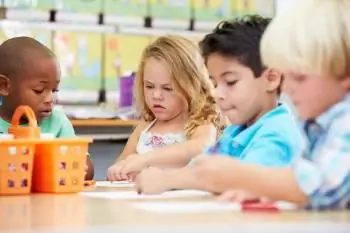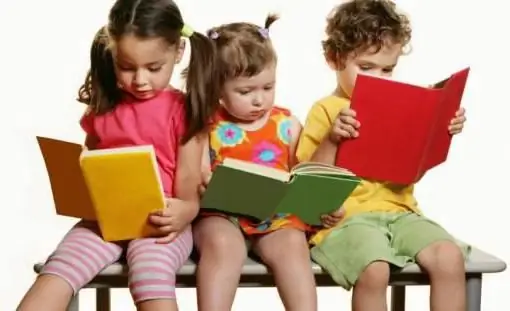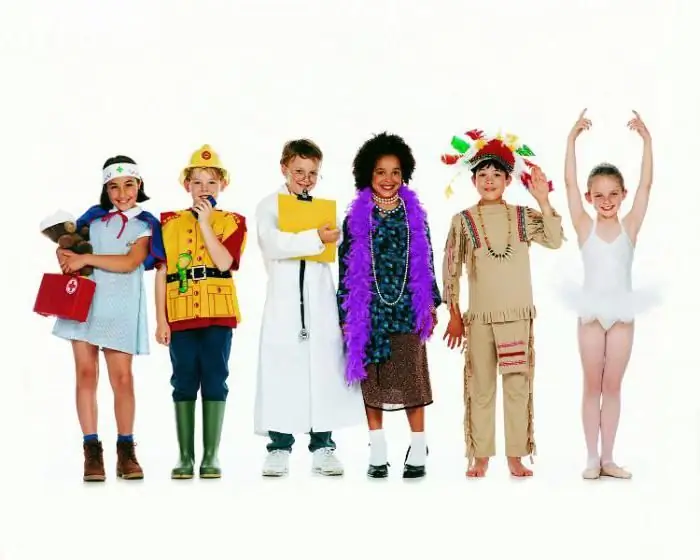2026 Author: Priscilla Miln | [email protected]. Last modified: 2025-01-22 17:55:15
It is necessary to lay the desire and ability to work in a child from preschool age. Proceeding from this, preschool institutions set one of the main goals of labor education of preschoolers. In accordance with the Federal State Educational Standard, this term is commonly understood as a system for the formation of industriousness and labor skills in each child. As well as the desire to learn how to work.
The main goal of the labor education of preschoolers is to form a careful attitude to any work and a clear idea of the work activity of adults.
In connection with this goal, the state standard identifies the following main tasks:
- Shaping clear ideas about adult work and the importance of work in life.
- Formationknowledge, skills and abilities necessary for labor activity.
- Educating a respectful attitude to any work.

Types of work and tasks
GEF DO involves the following types of labor:
- self-service;
- household work;
- natural labor;
- manual labor.
For each type, certain tasks of labor education of preschoolers can be distinguished.
| Type of work | Tasks |
| self-service |
|
| economic |
|
| natural |
|
|
manual |
|
It is important to consider that the first two types of labor activity should be formed throughout the years of being in kindergarten, and manual labor training begins only 1-2 years before graduation from preschool.

How does each type of work affect a child?
Thanks to the formation of self-service skills, pupils develop such qualities as self-confidence, the ability to independently solve their problems and be independent of parents or othersimportant adults.
The implementation of economic tasks allows children to understand that they can improve the environment on their own and without any help. All the knowledge that preschool gives children will play a significant role in the future.
Working in relation to nature helps children improve their mood, self-esteem; allows you to teach children to independently grow any product, flower and perform proper care for it; develops the child's thought processes.
Teaching manual labor helps children to believe in themselves and understand that they can make a beautiful thing on their own and please not only themselves, but also their loved ones with it.
Based on the above, it is worth concluding that it is very important to include all types of activities in the upbringing plan, because only thanks to this, the teacher will be able to graduate a person fully prepared for school and adult life from kindergarten.

Forms of work organization
For the full education of labor activity among preschoolers, the following forms should be used:
- orders;
- on duty;
- work together.
Let's consider in detail all aspects of each of the forms.
Assignments are the most pleasant and effective means of educating and developing labor qualities. Children really like it when they are given instructions by adults who are authoritative for them, and in order to receive praise from this person, they will try to do the assignment well,quickly and correctly.
There are three types of orders: individual, group, general.
You should start with assignments specifically for one child, and only then, at an older age, move on to group ones. In addition, at a younger age, assignments should be small and light. As the child grows, you should complicate the assignments.
It is very important to always praise the child not only for successful performance, but also for the desire and desire to help. You should not assume that helping a child in an assignment will have a negative result, on the contrary, by helping the kids, you realize in them a sense of security and confidence in others.
Duty duty is a specific task given to several kindergarten students, requiring special responsibility. Thanks to the duty, children feel their importance for the preschool institution, responsibility for completing the task and understand that their role and active participation in the group are important. In addition, duty unites the children's team, and a common cause helps children get to know each other better.
Cooperative work allows kids to correctly distribute responsibilities, choose roles for each participant and be responsible for the performance of their work to the group. Labor education of preschool children in accordance with the Federal State Educational Standard is implemented through the listed forms of activity, which were chosen by experienced teachers thanks to the research.

How to properly distribute classes?
In order to realize the goallabor education of preschoolers, it is necessary to correctly draw up an activity plan. It is very important to take into account age characteristics in the selection of activities.
It is worth noting that all forms of activity should be used and distributed with a load that is appropriate for children.
Incorrect planning of labor education in accordance with GEF DO and its outcome
| Action | Result |
| The teacher uses all three forms of work in one day. | The tasks of labor education of preschool children are implemented to a weak extent, due to the heavy burden on children. Pupils consider themselves not individuals, but subordinates, from whom they require a lot of work. |
| The teacher uses one form of activity per week. | Since it is absolutely impossible to involve all children in all types of forms, labor education in accordance with the Federal State Educational Standard will manifest itself only in the part of the pupils who were more involved in the activity. |
| The teacher incorrectly calculates the degree of difficulty of tasks. | For young children, he gives difficult tasks, and for the guys from the older group - simple and easy. This approach will cause children to have a negative attitude towards work, as it will be either very easy or too difficult for them. Moreover, this method can completely discourage the desire to work and respect human labor. |
In order to avoid suchmistakes, it is necessary to correctly distribute the responsibilities of children in the process of labor education.

Possible options for tasks for different ages
In order to implement the tasks of labor education of preschoolers as accurately as possible, an approximate table of activities for each group was compiled. You can see it below.
| Group | Options for tasks |
| Kindergarten\Junior | Two groups are combined into one type, since the age of the kids and their capabilities are approximately the same. At this age, you can give such instructions as watering a flower from a children's watering can (only one pot, if it's a street, then one small flower bed), taking a small object from one place to another, hanging your clothes to dry. Duties and collective tasks do not apply at this age. |
| Average |
Labor education of preschoolers in accordance with the Federal State Educational Standard in the middle group requires a little more complicated assignments. For example, independently water all the flowers in the group, carefully hang your things, arrange toys beautifully, etc. Begins acquaintance with a new form of labor activity - duty. The very first duty is in the dining room. Children need to ensure that everyone has cutlery, bread, cheese on the tables and carefully observe that all pupils wash their hands before eating. It is also possible to instruct the attendants to serve fruits or vegetables on the table, but not completely on the table, but2 each. |
| Oldest | In the older group, children are already older, and their opportunities have expanded significantly. Now it is worth introducing such a type of labor education as collective work. It is recommended to start with an interesting and exciting activity. A good teamwork at this age would be to grow a flower as a group. Each of the children will distribute their responsibilities: someone monitors the watering, someone loosens the earth, and someone ensures sufficient sunlight. Thus, the teacher forms in preschoolers a sense of love and care for the environment and the ability to work in a team. |
| Preparatory |
Labor education in accordance with GEF DO in this group is designed to seriously prepare future kindergarten graduates for big changes. It will be a new stage of life - school. Therefore, it is very important to prepare an independent, educated and hardworking first grader. To do this, it is necessary to alternate all forms of labor activity. It is obligatory to carry out collective work once a week, but not for long. That is, the work must be started and completed on the same day. This could be making collages, cleaning up the animal corner or outdoors, etc. The educator is obliged to develop the desire for work and the desire to work as much as possible. |

Work and parents
It is also important labor education of preschoolersin accordance with GEF for parents. In addition, the result of “inoculation” of love and a good attitude to work depends more on them.
Those rules that are present in a preschool should be used by parents at home. Otherwise, the mismatch of requirements can lead to a misunderstanding on the part of the child of what is required of him. The consequences of such disagreements are different: the minimum - the child will be constantly not sure whether he is doing the task correctly, the maximum - if in one place you need to do it this way, but in another it’s not necessary and you need it differently, then the child will decide that adults themselves they do not know what they expect from the baby and come up with the rules on their own. And if such requirements are just fiction, then they can not be met.
The problem of labor education of preschool children is solved only by the joint work of parents and educator. To do this, it is necessary to arrange parent-teacher meetings as often as possible, where they agree on the rules, tasks and methods of raising children. Parents, in turn, must attend all meetings and take an active part in them.
Remember, only by uniting you can achieve positive results! Do not blame all the work on educators, and then teachers. Their goal is only to direct the children in the right direction, and yours is to make every effort so that the child learns.
Hygienic conditions
In order for the labor education of preschoolers in accordance with the Federal State Educational Standard to have a positive result, it is imperative to monitor the hygiene of children and the cleanliness of the objects with which theywork.
The effectiveness of labor education of preschoolers in accordance with the Federal State Educational Standard increases when work takes place in the fresh air. If children work in an institution, then it is necessary to regularly ventilate the room and monitor the cleanliness of items.
When children are working on any craft or drawing, the room should be well lit so as not to harm children's eyesight.
The posture for work is of great importance. It is impossible for pupils to stay in one position for more than an hour, as this is very harmful for the emerging spine.
The importance of labor education for preschoolers
A person must learn to work, as this is the only source of a prosperous existence. Hard work from an early age ensures success and prosperity in the future. Children trained to work from infancy are more independent, easily adapt to any conditions and quickly solve various kinds of problems. Diligence allows a person to gain confidence in himself and tomorrow.
Labor education of preschoolers in accordance with the Federal State Educational Standard is aimed at maximizing the development of knowledge, skills and abilities of the child, thanks to which the kindergarten pupil will be able to develop safely further and receive the respect of relatives, friends and even strangers.

Conclusion
Labor education of preschoolers in accordance with the Federal State Educational Standard in the tables given in the article reveals in detail the essence and problems of the formation of industriousness.
The most important thing is to start involving children in the labor processfrom an early age. This must be done in a playful way, but with certain requirements. Be sure to praise the child, even if something does not work out for him.
It is important to note that it is necessary to work on labor education in accordance with age characteristics and it is important to take into account the individual capabilities of each child.
And remember, only together with parents can you fully realize the labor education of preschoolers in accordance with the Federal State Educational Standard!
Recommended:
Labor education of preschoolers as part of the social adaptation of children

Labor education of preschoolers should be carried out both in kindergarten and at home. It is thanks to the well-coordinated work of the kindergarten staff and parents that it is possible to instill in the child a love of work, respect for its results and certain moral qualities
Innovative technologies in preschool educational institutions. Modern educational technologies in preschool educational institutions

Today, teams of teachers working in preschool educational institutions (DOE) direct all their efforts to introduce various innovative technologies into their work. What is the reason for this, we learn from this article
Self-analysis of the lesson of the teacher of the preschool educational institution according to the Federal State Educational Standard and its main stages

Not so long ago, the priority of attending a preschool children's institution was to prepare the child for school. The teacher was tasked with teaching the child to read and write. But now, in the age of information technology, everything has changed. So, a number of changes were made to the Federal State Educational Standard, according to which the future student must leave the walls of the preschool educational institution adapted to the school system, a harmonious and developed personality, ready for all difficulties
Documentation of the preschool teacher in accordance with the Federal State Educational Standard. Checking the documentation of educators

Kindergarten teacher is a key figure. The entire microclimate of the group and the condition of each child individually depend on his literacy, competence, and most importantly, love and faith in children. But the work of an educator does not consist only in communicating and raising children. In view of the fact that state standards are now being introduced into educational institutions, the documentation of the teacher of the preschool educational institution in accordance with the Federal State Educational Standard is a necessary link in the work
Theatrical activities in the middle group according to fairy tales: planning, organization, goal, tasks, development

Theatrical activity in the middle group is a useful hobby for any child. Each theatrical performance teaches him something, reveals something new about the world that the baby knows so little about

